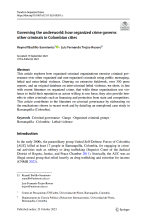By John Dunham & Associate
The Buy Safe America Coalition represents a diverse group of responsible retailers, consumer groups, manufacturers, intellectual property advocates and law enforcement officials who support efforts at all levels of government to protect consumers and communities from the sale of counterfeit and stolen goods. One important issue facing US businesses is the massive growth in the availability and sales of illicit products, both from counterfeit imports — increasingly from China — and from products stolen from legitimate retailers and sold through online marketplaces, where the anonymity of a screenname has made it easier and more profitable to fence counterfeit and stolen goods. The Coalition asked John Dunham & Associates (JDA) to examine the data around these illicit sales to determine how they impact the US economy, federal tax revenues, and criminal activity. This is the first of a series of papers examining the issue of counterfeit and stolen goods and its effect on the United States economy. This analysis will focus on the importation of illicit products, notably counterfeits that violate producers’ intellectual property rights. Future analysis will examine the effects of domestic smuggling, the resale of stolen goods, and the effects of contraband on overall criminal activity. According to the analysis: • A large share of contraband items are delivered to US consumers by mail or by express consignment. These transactions account for over 60.8 percent of all seizures by the US customs service and over 90 percent of intellectual property rights (IPR) seizures. The growth in these types of shipments has increased along with the use of online marketplaces. Amazon, for instance, now derives more than 75 percent of their ecommerce revenue from marketplace sales. • In effect, as companies like the Chinese ecommerce marketplace Alibaba and the Amazon marketplace, have linked more consumers to more shippers, many companies producing illegitimate products have gained access to unwitting consumers in America. • The bulk of counterfeit products to the US come from China and its dependent territories, accounting for over 90.6 percent of all cargo with IPR violations. Of the $1.23 billion in total IPR violations intercepted, $1.12 billion was from China. • Examining just those data where CBP can provide an HS code, in some cases, the amount of contraband cargo is nearly equal to the entire import base. For example, imports of certain sweaters, jumpsuits and toys from China are almost 100 percent contraband, as are large amounts of handbags, jewelry and belts. • While there is substantial academic literature on the smuggling of narcotics, people and tobacco, there is very little written on counterfeit products. Using a very conservative model it is estimated that $44.3 billion in additional illicit cargo is escaping detection. • These lost sales alone mean that over 39,860 jobs in wholesaling and nearly 283,400 retail jobs are lost due to the impact of counterfeit goods skirting normal trade channels. All told, the sale of counterfeit items is expected to cost the wholesale and retail sectors of the US economy nearly 653,450 full-time equivalent jobs that pay over $33.6 billion in wages and benefits to US workers. • It is estimated that the smuggling of counterfeit goods costs the US government nearly $7.2 billion in personal and business tax revenues alone. • This analysis is based on the current level of CBP intercepts of illicit cargo. It is likely that the number of illegal imports is much larger than even estimated here.
Washington, DC: Buy Safe America Coalition, 2021. 25p.





















